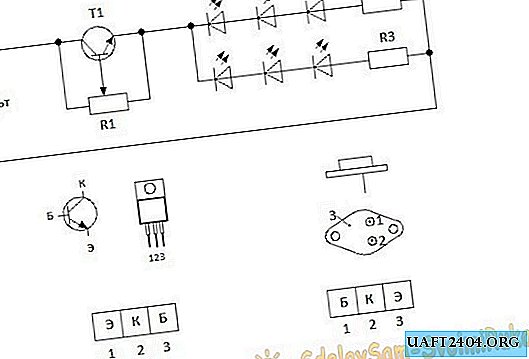Share
Pin
Tweet
Send
Share
Send
A voltage of 12 volts is considered completely safe for people. If you use an LED strip in your work, then we can assume that you will not suffer from a fire either, since the tape practically does not heat up and cannot catch fire from overheating. But accuracy is needed in order to prevent short circuits in the mounted device and as a result of a fire, which means to preserve their property.
Transistor T1, depending on the brand, can adjust the brightness of the LEDs with a total power of up to 100 watts, provided that it is installed on a cooling radiator of the corresponding area.
The operation of the transistor T1 can be compared with the operation of an ordinary faucet for water, and the potentiometer R1 - with its handle. The more you unscrew - the more water flows. So it is here. The more you turn off the potentiometer, the more current flows. You twist - less flows and less light emitting diodes.
Regulator circuit

For this scheme, we do not need numerous details.
Transistor T1. You can apply KT819 with any letter. KT729. 2N5490. 2N6129. 2N6288. 2SD1761. BD293. BD663. BD705. BD709. BD953. These transistors need to be selected depending on what power of the LEDs you plan to regulate. Depending on the power of the transistor, its price is also found.
Potentiometer R1 can be any type of resistance from three to twenty kilos. A potentiometer with a resistance of three kilo-ohms will only slightly reduce the brightness of the LEDs. Ten kilograms - will reduce to almost zero. Twenty - will adjust from the middle of the scale. Choose what suits you best.
If you use an LED strip, then you do not have to bother with the calculation of the damping resistance (on the diagrams R2 and R3) according to the formulas, because these resistances are already mounted in the strip during manufacture and all that is needed is to connect it to a voltage of 12 volts. Only you need to buy a tape for a voltage of 12 volts. If you connect the tape, then exclude the resistance R2 and R3.
They also produce LED assemblies designed for 12 volt power supply, and LED bulbs for cars. Extinguishing resistors or power drivers are built into all of these devices during manufacture and are directly connected to the vehicle’s on-board network. If you are only taking the first steps in electronics, then it is better to use just such devices.
So, we decided on the components of the circuit, it's time to start assembling.

We screw the transistor onto the cooling radiator through a heat-conducting insulating gasket (so that there is no electrical contact between the radiator and the vehicle electrical system, to avoid short circuit).

Cut the wire into pieces of the desired length.

We clean from isolation and tin tin.

We clean the contacts of the LED strip.

Solder the wires to the tape.

Protecting exposed contacts with a glue gun.

Solder the wires to the transistor and isolate from shrink cambric.

We solder the wires to the potentiometer and isolate them with heat-shrinkable cambric.

We assemble a circuit using a contact block.
We connect to the battery and test it in different modes.





Everything works well.
Watch the video of the regulator
Share
Pin
Tweet
Send
Share
Send











